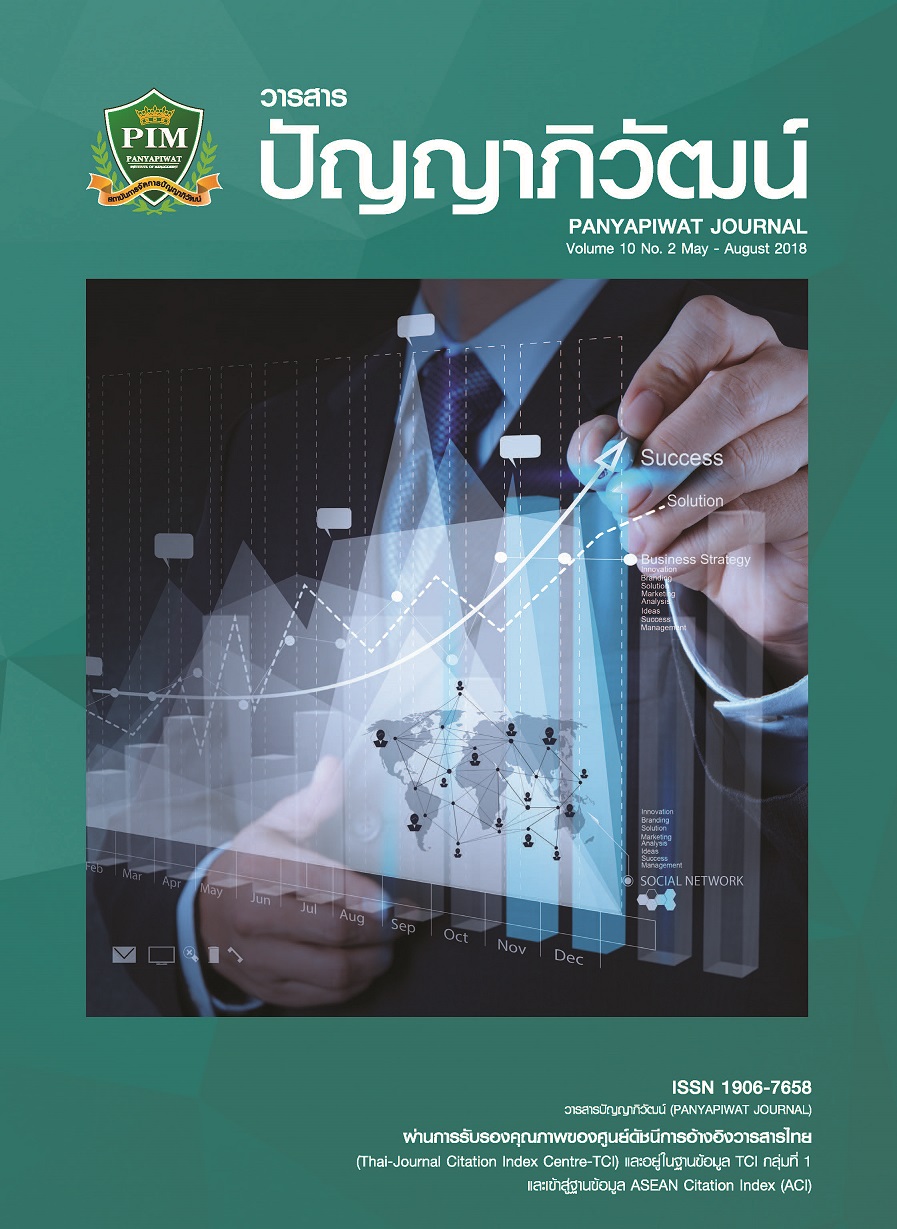STUDY ON THE INFLUENCE OF INVOLVEMENT DEGREE ON CUSTOMER FORGIVENESS IN CATERING INDUSTRY UNDER THE PRODUCT-HARM CRISIS
Main Article Content
บทคัดย่อ
The catering industry takes an extremely important position in the social life. The research on product harm has received the attention of many scholars, but the current research results are mostly concentrated on the situation after the crisis occurs, the attitude of the enterprise itself as well as the enterprise’s harm caused by the crisis. On the basis of the cases of product harm crises in the catering industry that happened in recent years, this paper puts forward relevant assumptions, then conducts verification through an experimental questionnaire survey, and studies the impact of consumers’ involvement on their forgiveness to enterprises in “severe” and “mild” crises. Through the correlation analysis of the questionnaire and regression analysis, it is concluded that under the background of severe product harm crisis, advertisements in product involvement and willing to read articles on consumer reports are positively related to forgiveness.
Under the background of mild product harm crisis, being interested in product description in product involvement, willing to read articles on consumer reports and willing to compare the different characteristics of food and beverage brands are positively related to forgiveness. The research results enrich the theories of related industries.
Article Details
“ข้าพเจ้าและผู้เขียนร่วม (ถ้ามี) ขอรับรองว่า บทความที่เสนอมานี้ยังไม่เคยได้รับการตีพิมพ์และไม่ได้อยู่ระหว่างกระบวนการพิจารณาลงตีพิมพ์ในวารสารหรือแหล่งเผยแพร่อื่นใด ข้าพเจ้าและผู้เขียนร่วมยอมรับหลักเกณฑ์การพิจารณาต้นฉบับ ทั้งยินยอมให้กองบรรณาธิการมีสิทธิ์พิจารณาและตรวจแก้ต้นฉบับได้ตามที่เห็นสมควร พร้อมนี้ขอมอบลิขสิทธิ์บทความที่ได้รับการตีพิมพ์ให้แก่สถาบันการจัดการปัญญาภิวัฒน์หากมีการฟ้องร้องเรื่องการละเมิดลิขสิทธิ์เกี่ยวกับภาพ กราฟ ข้อความส่วนใดส่วนหนึ่งและ/หรือข้อคิดเห็นที่ปรากฏในบทความข้าพเจ้าและผู้เขียนร่วมยินยอมรับผิดชอบแต่เพียงฝ่ายเดียว”
เอกสารอ้างอิง
Chung, E. & Beverland, M. B. (2006). An Exploration of Consumer Forgiveness Following Marketer Transgressions. Advances in Consumer Research, 33, 98-99.
Chung, E., Beverland, M. B. & Gabbott, M. (2004). An Exploration of Consumer Forgiveness Following Marketer Failure. Advances in Consumer Research, 1, 98.
Cui, P., Yang, Y. & Li, W. (2015). The Research on the Impact of CSR Strategy on Brand Trust after Product Harm Crisis: The Effect of Moderator and Mediator. Journal of Central University of Finance & Economics, (2), 69-74. [in Chinese]
Davidson, W. N. & Worrell, D. L. (1992). Research notes and communications: The effect of product recall announcements on shareholder wealth. Strategic Management Journal, 13(6), 467-473.
Dawar, N. & Piillutla, M. (2000). Impact of Product-harm Crisis on Brand Equity: the Moderating Role of Consumer Expectations. Journal of Marketing, 37(2), 215-226.
Eastetal. (2008). The making of the USA Patriot Act II: Public sentiment, legislative climate, political games man ship, media patriotism. International Journal of the Sociology of Law, 34(2), 105-140.
Engel, J. F. & Blackwell, R. D. (1982). Consumer behavior (4th ed.).New York: Dryden press.
Fang, Z., Yang, Y., Li, W. & Cai, J. (2013). The Spillover Effect of Product Harm Crisis: How to Resolve Product Harm Crisis Triggered by Others. Nankai Business Review, 6, 19-27. [in chinese]
Fesenmaier, D. R. & Xiang, Z. (2014). Tourism marketing from 1990–2010: Two decades and a new paradigm. The Routledge Handbook of Tourism Marketing, (1), 31-39.
Finkel, E. J. & Rusbult, C. E. (2008). Prorelationship motivation: An interdependence theory analysis of situations with conflicting interests. Handbook of motivation science, 547-560.
Finkel, E. J., Rusbult, C. E., Kumashir, M. & Hannon, P. A. (2002). Dealing with betrayal in close relationships: Does commitment promote forgiveness? Journal of Personality and Social Psychology, 82(6), 956-974.
Houston, M. & Rothschild, M. L. (1978). Conceptual and Methodological Perspectives on Involvement, Educator’s Proceedings. American Marketing Associations, (44), 184-187.
Jin, M. & Qian, S. (2018). Consumer Substitution Behavior in Food Safety Crisis–Driving Effect and Anchoring Effect. Journal of Shanxi University of Finance and Economics, 40(1), 12-25. [in Chinese]
Klein, J. & Dawar, N. (2004). Corporate social responsibility and consumers’attributions and brand evaluations in a product–harm crisis. International Journal of Research in Marketing, 21(3), 203-217.
Lastovicka, J. L. & David M. G. (1979). Low involvement versus high involvement cognitive struc-tures. In H. keith Hurt. Advance in consumer research. Ann Arbor: Association for con-sumer research.
Laufer, D. & Coombs, W. T. (2006). How should a company respond to a product harm crisis? The role of corporate reputation and consumer-based cues. Business Horizons, 49(5), 379-385.
Qing, P., Li, H. & Jiang, X. Y. (2014). Research on the Reverse Communication Behavior Mechanism of Consumers’ Network under the Background of Product Harm Crisis–A Case of Agricultural Products. Issues in Agricultural Economy, (12), 85-95. [in Chinese]
Ren, J. & Jing, F. (2015). The Impact of Corporate Crisis Response Regulatory Fit on Forgiveness under Ambiguous Product Harm Crisis. Chinese Journal of Management, 12(4), 583-592. [in chinese]
Siomkos, G. J. & Kurzbard, G. (1994). The Hidden Crisis in Product-harm Crisis management. European Journal of Marketing, 28(2), 30-41.
Siomkos, G. J. (1999). On achieving exoneration after a product safety industrial crisis. Journal of Business & Industrial Marketing, 14(1), 17-19.
Slama, M. E. & Tashchian, A. (1985). Selected socioeconomic and demographic characteristics associated with purchasing involvement. Journal of Marketing, 49(1), 72-82.
Wang, X., Chao, G. & Wu, J. (2008). Responses to Product-harm Crisis and Variation of Consumer Consideration Set–A Cross-category Contrast. Chinese Industrial Economy, 7, 36-46. [in chinese]
Wei, H. & Wei, W. (2011). The impact of consumers’ forgiveness willingness on product harm crisis. Economic Management Journal, 33(8), 101-108. [in Chinese]
Yang, Y., Deng, F. & Fang, Z. (2012). The research on the effect of repair strategy on brand equity in negative publicity. China Business and Market,26(1), 90-95. [in chinese]
Zaichkowsky, J. L. (1985). Measuring the involvement construct. Journal of Consumer Research, 12(3), 341-352.
Zaichkowsky, J. L. (1994). The personal involvement inventory: Reduction, revision, and application to advertising. Journal of Advertising, 23(4), 59-70.
Zhang, B. & Lin, J. (2017). Research on the Impact of Product Harm Behaviors of Food Enterprises on Consumers’ Adverse Selection–Based on the Perspective of Brand Assets. Consumer Economics, 33(2), 45-51. [in chinese]
Zhang, M., Xu, X. & Fu, X. (2014). Impact of Negative Events on Brand Relationship in Restaurant Services: Experimental Study from the Perspective of Hierarchy of Customers’ Interests. Tourism Tribune, 4, 69-78. [in chinese]


